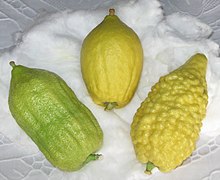Etrog
The Etrog ( Hebrew אתרוג, Yiddish Essrig ) are different varieties of the citron that are used by Jews during the Feast of Tabernacles, or Sukkot . The etrog belongs to the festive bouquet prescribed in Leviticus 23:40, which is formed from a palm branch ( lulav ), myrtle branch (Hadassim), brook willow (Arawot) and apple of paradise (etrog). The latter is literally referred to as the "fruit of the Hadar tree", referred to as the Etrog in the Babylonian Talmud , Tract Sukkah 34, and traditionally identified with the apple of Paradise that Adam ate from. That is why the etrog is also called Adam's apple or paradise apple .
Since their exile in Babylon (597–539 BC), Jews had known the citronate lemon. As a symbol of the religious and national unity of the Jews, it appears on numerous frescoes, mosaics, tombs and ritual objects in the Holy Land from the 1st century BC. Chr. On.
biology
The citron, one of the three original types of citrus fruits alongside grapefruit and tangerine, originally comes from Assam at the foot of the Himalayas. Assam, with its mild climate and large amounts of rainfall , offered these plants ideal growing conditions. To grow outside of this region in hotter and drier areas, the plant needs human care. Outwardly it resembles an oversized lemon , is yellow to green-yellow in color and has a thick, pitted skin. There may be a crown-like finish at the top. The pulp and skin are bitter, the wood of the plant contains a strongly scented oil.
Lemon trees that are used as etrogs are not grafted. In contrast to other citrus lemons, which are usually grafted onto bitter oranges, they therefore remain smaller and are slower to grow. The leaves end in a rounded tip and the leaf edge is often curved downwards. As with other citrus lemons, the young shoots, leaves and flower buds are reddish in color.
The fruit is small for a lemon. When ripe it is colored yellow. It is oval, narrowing at both ends, with a small protuberance at the tip. Often the stylus and the scar are still present at the tip during the ripening period . The surface is rough and sometimes slightly ribbed. There is little pulp under the thick, fleshy skin. This is sour and not very juicy, it contains the seeds.
Meaning in Judaism
The fruit used in the festival of Sukkot must be intact, pure and spotless. The point called pitum must not have broken off; Species that naturally do not have such a crown are also accepted. The etrog must not come from a grafted tree. A specimen is particularly valuable because of the groove-like notch that is sometimes found, known as the Adam's bite .
During the prayer, the etrog is held in the left hand while the other three plants are tied together and held in the right hand. In Haggadan literature, the festive bouquet is often interpreted symbolically, e.g. B. as a symbol of Israel and its structures, as a symbol of the patriarchs and mothers and their virtues, or as the glorification of God and his attributes (Wajikra Rabba 30). Popular belief is that pregnant women bite off the pitum of the fruit to reduce pain during childbirth. The Etrog is also said to help infertile women.
In arts and crafts, the etrog is represented many times. The Etrog container, in which the fruit is kept, found a special form. There are also Etrog bowls that can be artistically decorated. Etrog and Lulav were often depicted on ancient synagogue mosaics.
The different groups within Judaism use different varieties of the citron as an etrog, the garden historian Attlee speaks of at least 12 clearly distinguishable varieties. The determination is made by the respective Posek . The Lubavitch Jews , a Hasidic group within Orthodox Judaism , use the diamante lemon ( Citrus medica var. Vulgaris or Citrus medica cv. Diamante ; Italian cedro di diamante , Hebrew) as an etrog on the instructions of their Rebbe Menachem Mendel Schneerson אתרוג קלבריה or גינובה). This variety grows exclusively along a 40 km long coastal strip along the northern Calabrian coast between Tortora and Belvedere Marittimo . The trees are harvested twice a year. The harvest time, which takes place around August, is used almost exclusively for the festival of tabernacles. During this time there are numerous representatives of this faith in northern Calabria who monitor that the fruits come from plantations that meet the requirements and buy suitable fruits for the Lubowitscher communities that are today all over the world. Only a very small part of the harvest meets the high demands on Etrog. Perfect fruits that meet the requirements are traded for prices between € 25 and € 250.
The use of this variety is entirely conclusive: the Jewish migrants who settled in Italy, Sicily, Greece and Spain after the conquest of Jerusalem in AD 70, imported the lemon that they had previously grown in the Holy Land .
literature
- Helena Attlee: The Land Where Lemons Grow: The Story of Italy and its Citrus Fruit. Penguin Books, London 2015, ISBN 978-0-14-196786-8 .
- Louis Loeb: Esrog box . In: Reallexikon zur Deutschen Kunstgeschichte , Vol. 6, 1968, Sp. 40–42
- W. Reuther, H. J. Webber, L.D. Batchelor (Eds.): The Citrus Industry . Vol. 1 & 2. University of California, 1967, ucr.edu
- Jewish Lexicon . Vol. II. Jewish publishing house, Berlin 1927
- Jewish festival, Jewish custom . Jewish publishing house, Berlin 1936




